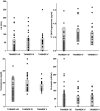Metabolic and reproductive features before and during puberty in daughters of women with polycystic ovary syndrome
- PMID: 19223518
- PMCID: PMC2730345
- DOI: 10.1210/jc.2008-2836
Metabolic and reproductive features before and during puberty in daughters of women with polycystic ovary syndrome
Abstract
Context: A significant proportion of the first-degree female relatives of women with polycystic ovary syndrome (PCOS) may be at risk for developing PCOS. However, it is not known at which stage of pubertal development the hormonal and metabolic abnormalities ensue in PCOS.
Objective: The aim of the study was to assess the reproductive and metabolic profiles of daughters of women with PCOS (PCOSd) during the peripubertal period, a stage during which the gonadal axis is activated and PCOS may become clinically manifest.
Design: Ninety-nine PCOSd [30 prepubertal and 69 pubertal (Tanner II-V)] and 84 daughters of control women (Cd) (20 prepubertal and 64 pubertal) were studied. An oral glucose tolerance test, a GnRH agonist test (leuprolide acetate, 10 microg/kg sc), and a transabdominal ultrasound were performed. Gonadotropins, sex steroids, SHBG, glucose, insulin, and lipids were determined.
Results: Both groups had similar chronological ages and body mass index sd scores according to Tanner stage distribution. Ovarian volume and 2-h insulin were significantly higher in PCOSd compared to Cd at all Tanner stages. In Tanner stages IV and V, basal testosterone and poststimulated LH, testosterone, and 17-hydroxyprogesterone concentrations were significantly higher in PCOSd compared to Cd.
Conclusions: Hyperinsulinemia and an increased ovarian volume are present in PCOSd before the onset of puberty and persist during pubertal development. The biochemical abnormalities of PCOS appear during late puberty. Considering the early onset and the nature of the alterations, PCOSd constitute a high-risk group for metabolic and reproductive derangements.
Figures



Comment in
-
Polycystic ovary syndrome--"A riddle wrapped in a mystery inside an enigma".J Clin Endocrinol Metab. 2009 Jun;94(6):1883-5. doi: 10.1210/jc.2009-0492. J Clin Endocrinol Metab. 2009. PMID: 19494163 No abstract available.
References
-
- Franks S 1995 Polycystic ovary syndrome. N Engl J Med 333:853–861 - PubMed
-
- Holte J 1996 Disturbances in insulin secretion and sensitivity in women with the polycystic ovary syndrome. Baillieres Clin Endocrinol Metab 10:221–247 - PubMed
-
- Dunaif A, Segal KR, Futterweit W, Dobrjansky A 1989 Profound peripheral insulin resistance, independent of obesity, in polycystic ovary syndrome. Diabetes 38:1165–1174 - PubMed
-
- Ehrmann DA, Barnes RB, Rosenfield RL, Cavaghan MK, Imperial J 1999 Prevalence of impaired glucose tolerance and diabetes in women with polycystic ovary syndrome. Diabetes Care 22:141–146 - PubMed
-
- Legro RS, Kunselman AR, Dodson WC, Dunaif A 1999 Prevalence and predictors of risk for type II diabetes mellitus and impaired glucose tolerance in polycystic ovary syndrome: a prospective, controlled study in 254 affected women. J Clin Endocrinol Metab 84:165–169 - PubMed
Publication types
MeSH terms
Substances
Grants and funding
LinkOut - more resources
Full Text Sources
Other Literature Sources
Medical
Miscellaneous

